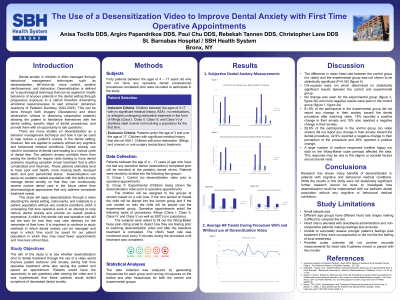Patient Management
Use of Desensitization Video to Improve Dental Anxiety with Operative
410 - The Use of a Desensitization Video to Improve Dental Anxiety with First Time Operative Appointments


Anisa Tocilla, DDS
Resident
St. Barnabas Hospital
Briarcliff Manor, New York, United States- PC
Paul Chu, DDS
Program Director
St. Barnabas Hospital
Bronx, New York, United States
Presenting Author(s)
Program Director(s)
Purpose: This controlled prospective study aims to see how a child’s behavior and anxiety could be improved regarding first time operative appointments with a desensitization video.
Methods: TThis study will aim to provide both desensitization and necessary dental work in one appointment by allowing the patient to familiarize themselves with the dental setting and specific steps of dental procedures by watching a video. The study will be performed on 40-100 children ages 4-17 who have not had any operative dental treatment completed in the past. There will be a control and experimental group to which subjects will be assigned randomly. The subject will be asked to fill out the Wong-Baker faces pain rating scale to depict how they are feeling prior to watching desensitization video and after the operative treatment is completed. The child’s heart rate will be monitored once every 5 minutes during the procedure.
Results: The difference in mean heart rate between the control group and the experimental group was not statistically significant (P>0.05). 61.9% of the participants in the experimental group and 28.6% in the control group did not report any change in their anxiety toward the dental procedure after watching the video.
Conclusion: While the results in this study were not statistically significant perhaps due to a small sample size. Further research should be done to investigate how desensitization could be implemented in patients without any cognitive or behavioral medical conditions.
Identify Supporting Agency and Grant Number: Research supported by St. Barnabas Hospital.

.jpg)